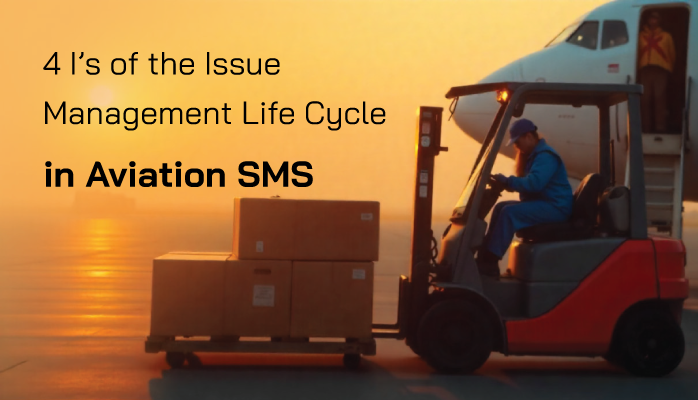What the Issue Management Life Cycle Is

The life cycle of hazard and risk occurrence (including other types of occurrences) encompasses the entirety of an adverse event to final consequences.
The process that follows the hazard/risk occurrence life cycle is the issue management life cycle.
The issue management life cycle includes all the steps management takes from identifying an issue to fixing the issue (and beyond this, monitoring the fix). Various aviation compliance agencies account for this life cycle with various names, such as the FAA’s Safety Assurance process.
However, these processes account for much more than just the issue management life cycle, as they include monitoring and review activities. The issue management life cycle is concerned with what happens between;
- Ingesting issues; and
- Implementing changes.
The four general stages of the issue management life cycle are:
- Ingest an issue through various hazard reporting methods;
- Investigate the causes of the issue, such as the root causes and Human Factors;
- Identify how to fix the causes of this problem through detection, prevention, and/or correction; and
- Implement changes that fix causes via corrective actions.
Here is a more detailed look at each of these stages.
SMS Ingest Reports Via Hazard Reporting Process
Ingesting issues is the basis of issue management. Without issue reporting, there is nothing for managers to manage. Therefore, ingesting is critical to the continued improvement of SMS. The extent and quality of issue ingestion depend largely upon hazard reporting culture.
Ingesting issues happen in the following way:
- You have a hazard reporting system;
- Your hazard reporting system includes one or more ways to report issues, which probably includes one or more hazard reporting forms;
- Employees identify a concern in the operational environment;
- They report the issues; and
- The act of reporting is how your SMS “ingests” issues.
In this manner, building your issue management process begins with promoting an aviation hazard reporting culture.
Related Articles on Hazard Reporting in Aviation SMS
- Best Practices for Hazard Reporting in Aviation SMS - With Examples
- How to Develop a Hazard Reporting System in Aviation SMS [With Free Checklist]
- Solution for What to Do When Hazard Report Submission Fails (and All Your Work Seems Lost)
Investigate What Caused the Problem
As each report comes in, managers need to thoroughly investigate the problem. In essence, investigating the concern involves establishing the life cycle of the issue in question.
Investigation is aimed at being able to list:
- Root causes that caused the issue;
- Contributing factors, i.e. initiating mechanisms;
- The primary hazard or focal point of the concern;
- Human Factors that contributed positively/negatively to the outcome; and
- If applicable, the adverse events and consequences that resulted from the hazard occurrence.
An appendage to investigating the issue is assessing the issue, which necessarily depends on investigating all aspects of the issue.
Identify How to Fix the Problem

Once an issue has been investigated, managers need to figure out how to fix the problem. This involves taking all findings from the investigation and highlighting the primary elements that negatively affected the problem.
This involves usually:
- Trying to fix the root causes with risk controls in order to prevent hazard occurrence; and/or
- Reinforcing risk controls to mitigate the threat(s) once the hazard has occurred, and therefore prevent risk occurrence(s).
Once the main problem areas are identified, managers need to formulate a plan to fix these main problem areas by:
- Figuring out a way to detect the problem in the future;
- Figuring out how to correct the problem, so its likelihood of happening again is much reduced; and/or
- Figuring out how to introduce changes in operational environment to prevent the problem from happening again.
This step in the issue management life cycle should involve:
- Brainstorming; and
- Further, risk assessments to ensure that proposed solutions actually fix the problem.
These “fixes” are done through corrective-preventative actions.
Implement Changes With Corrective Actions
Once management is sure that proposed fixes will mitigate a reported issue, they usually need to implement these fixes. Corrective preventative actions (CPAs) are either:
- Actions undertaken to correct the issue; or
- Risk controls implemented to fix the issue.
Things like remedial training, probation, etc., are not ways of fixing the issue that needs to be “implemented.” However, many CPAs will need to be implemented, such as via:
- Making changes to existing SMS documentation (policies, etc.);
- Introducing new changes to the existing SMS (i.e., a new task checklist); or
- Creating or updating new resources in the operational environment (i.e., new software, updated machinery, etc.).
Once these changes are implemented, they will need to be reviewed and monitored as a part of overall system monitoring.
Related Articles on Corrective Action in Aviation SMS
- What Is a Corrective Action in Aviation SMS?
- Tips Tying Corrective Action Preventive Action to Hazard Register
- All Corrective Preventative Actions Not Created Equal: Initial Mitigating Actions
Here are great resources that will help you with the issue management life cycle:
Last updated September 2025.






